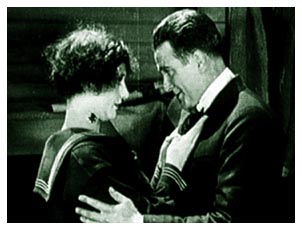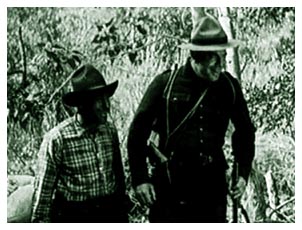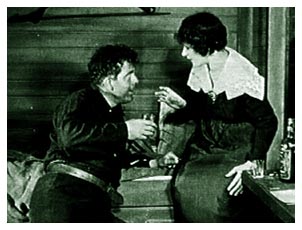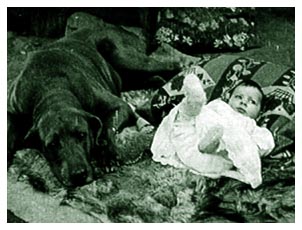

Curwood-Carver Company
Distributed by First National Pictures
Cast: Nell Shipman (Dolores LeBeau), Wheeler Oakman (Peter Burke), Wellington Playter (Rydal), Charles Arling (Sealskin Blake), Roy Laidlaw (Baptiste LeBeau), William Colvin (the Mountie), Charles B. Murphy (Rydal's half-breed friend)
Dolores and her father live in the beautiful forests in
the Canadian wilderness. Dolores' great love is the animals that
she has befriended. Their cabin is often filled with bears, raccoons,
deer, ducks and various other wildlife. Peter Burke, a naturalist
and investigator for the Government, arrives in the area for some
work, is invited to stay with Dolores and her father, and the
two young people fall in love. Nearby is Rydal, "a lawless
trading vessel master" who is being hunted by the Mounties
for murder. When a Mountie finds him and arrests him, Rydal's
half-breed friend shoots from behind a bush and kills the Mountie.
Rydal puts on the Mountie uniform and, along with his friend,
soon happens upon the cabin while Burke is away on an excursion.
Before Burke can return, Rydal tries to rape Dolores, her father
kills Rydal's half-breed friend, and Rydal kills her father.
Burke returns just in time to see Dolores pull her dead father
from the river. They move to Montreal and marry. To satisfy
Dolores' desire to return, they book passage on a ship that will
take them to the remote area where the cabin is located. Well
into the voyage, they learn that Rydal is the captain of the ship.
He arranges to drop a sail boom on Burke nearly killing him.
They sail into a small outpost where the owner, Blake, is a compatriot
of Rydal's. The two plot to finish off Burke, but Dolores learns
of their plan. She decides they must attempt the dangerous 200-mile
trip to Ft. Confidence where the closest doctor is located. She
makes a nighttime escape on a dogsled with her sick husband while
Rydal chases close behind in another dog sled. Earlier, Dolores
had made a friend of the vicious dog, Wapi, who would let no human
get near him until she came along.  Wapi
repays her kindness at just the right time during the escape.
Wapi
repays her kindness at just the right time during the escape.
"Back to God's Country" plays like a condensed feature version of a serial. The story moves along in a series of rapid vignettes - just as one predicament is overcome, another arises. It has a steady rhythm, not staccato by any means, but steady so that the interest and anticipation seldom cease to grip the viewer.
The film is based on James Oliver Curwood's "Wapi, the Walrus" which was published in the November and December, 1918, issues of Good Housekeeping magazine. Star Nell Shipman wrote the scenario for the movie and admitted that she made significant changes from Curwood's original story - which were not very pleasing to the author - at least not initially. "James (Curwood) had already damned the scenario as prepared by me," she said when the two met in Calgary, Alberta, Canada, as preparation for shooting began. "It did go rather far beyond and behind 'Wapi, the Walrus,'" she admitted. With admonitions from the director and others in the company to give in to any demands he may have, Shipman and Curwood locked themselves away in a room to work out the problems with the script.
According to Shipman, "'Now, right here at the beginning,' he said, snarling a bit, 'is the first error. You say 'Iris in.' This is no character in my story named Iris.'" After explaining to him that this was a technical term for fading into a scene, she said "I suppose the boo-boo upset my non-technical partner. He listened more quietly and with growing enthusiasm as we went through the script, typed page and scrawled annotation. . . When Star and Author came from the session, arm-in-arm, the news of unification was shouted to the anxious management and the worried director. 'We've added a million dollars to the picture!' cried James Oliver Curwood."
As noted, the story as filmed is riveting and arouses all the necessary emotions. The characters are well-defined and developed, and the decision to film in the Canadian wilderness brings the necessary reality and believability to the film. Shipman's scenario is well-done, almost all of the characters are well played, and the cinematography is well above average.
Special commendation goes to Wellington Playter for his portrayal of the villain, Rydal. Playter only made about 25 films between 1913 and 1921, and, for some unknown reason, has no films to his credit after that. At about 40 years old at the time of "Back to God's Country," her certainly wasn't too old to continue in pictures. He only made one more picture after "Back to God's Country" and died at the age of 58 in 1937.
 His character, Rydal, is "a
lawless trading vessel master" who is on the run in the Canadian
wilderness for murder. A Mountie locates him and manages to arrest
him, but Playter's friend shoots the Mountie from the bushes.
Rydal dons the Mountie's uniform and later he and his friend
happen upon Dorothy swimming nude in a lake. Unlike the typical
male of this cinematic period who would turn quickly in embarrassment,
Rydal leers lasciviously at the beautiful young girl, adding even
more to his despicable portrayal.
His character, Rydal, is "a
lawless trading vessel master" who is on the run in the Canadian
wilderness for murder. A Mountie locates him and manages to arrest
him, but Playter's friend shoots the Mountie from the bushes.
Rydal dons the Mountie's uniform and later he and his friend
happen upon Dorothy swimming nude in a lake. Unlike the typical
male of this cinematic period who would turn quickly in embarrassment,
Rydal leers lasciviously at the beautiful young girl, adding even
more to his despicable portrayal.
Of this scene, Shipman said, "In 'Back to God's Country' I did the nude swim and Wellington Playter peeked from behind his whiskers and a convenient tree. Only the pine was not near the pool set-up either by calendar or actual location. Mr. Playter and all the Cast had long since completed their chores when I did my dive at the Kern River location before a camera and a limited audience."
The fact that he pursues Dorothy throughout the picture,
even to the point of trying to kill her husband to get him out
of the way, keeps the viewer glued to the screen and eliciting
the appropriate amount of hate and disgust for this loathsome
beast.
Of Playter, Shipman said, " . . . the Curwoodian Meanie
(was) played by Wellington Playter, big, husky, menacing and as
nice a person off-camera as one might wish to know."
The dependable Wheeler Oakman plays the love interest, but the story gives us no reason to cheer for his character, Peter Burke, a naturalist and investigator for the government. Although Nell Shipman is certainly the heroine of the picture, it's difficult to label Oakman as the "hero." When trouble arises, he is never in a position to help. For example, when Rydal almost rapes Dorothy and then kills her father, he is away and returns to late. After he and Dorothy are married, they decide to sail back to the old cabin she and her father shared in the wilderness. It turns out that Rydal is the captain of the ship, and he arranges to have a mast beam fall on Burke. Incapacitated, Dorothy must fend for herself against the villain and even risk death, darkness, cold and bad guys driving a dog sled to get him to a doctor.
Although at the end of the picture, this scene was filmed early on. In the sled was her original leading man - handsome Australian Ronald Byram. However, he quickly contracted pneumonia. "We last saw him on a hurried visit to the Edmonton hospital after jolting south on the Northern Alberta RR," Shipman said. Sadly, she added, "Neither we nor the homeland folks Down Under would eve see him again."
Oakman was brought in as a replacement, however, in the long shots of the sled as it dashes through the snow toward Ft. Confidence, the sick husband bundled up in the sled is Byram." Another sad announcement during the filming of "Back to God's Country" was the death of Shipman's father in Glendale. Because of their remote location, she didn't learn of his death until after he was buried and, at that point, she chose to continue with the filming rather than go home.
Probably the weakest choice for a part in the film is that
of Dorothy's father portrayed by Roy Laidlaw. Between 1915 and
1928, Laidlaw had over 40 films to his  credit.
The criticism is not his acting; he was simply too young-looking
to play Dolores' father. Only 36 years old at the time the film
was made, the poor make-up job did nothing to hide his youthful
appearance, thereby spoiling the illusion of an older man who
is abused by the baddie Rydal.
credit.
The criticism is not his acting; he was simply too young-looking
to play Dolores' father. Only 36 years old at the time the film
was made, the poor make-up job did nothing to hide his youthful
appearance, thereby spoiling the illusion of an older man who
is abused by the baddie Rydal.
Shipman herself does a commendable job and deserves kudos for bringing this story to the screen in such a successful fashion. The fact that she chose the real Canadian scenery as opposed to staging a wilderness is California is to her credit.
"We lived in the log cabins of he absent fishermen," she said. "I was deadly cold, sixty-below on one night's shooting when I, as the runaway Girl yenned for by the evil captain of the ice-bound ship, mushed endless camera miles over the frozen waste of Lesser Slave Lake, my wounded leading man husband helpless in the sled."
The realism comes through, and, without it, the film would have just been another melodrama. As a matter of fact, Variety (January 2, 1920) still saw it as nothing more than a typical "meller" from the period. "The picture is a meller of the real old-fashioned kind, and after reading the story and seeing the picture, it seems that the James Oliver Curwood tales make better reading than they do screen material. . . In all, the picture will be a novelty to most audiences because of the dog hero, and it will get by on that account; otherwise it is just one of the regular run of screen melodramas."
Shipman was a fine actress - not on a level with a Pickford or a Gish - but she handles the various situations - near-rape by the villain, fear when he spies her swimming nude, agony over the death of her father, desperation when her husband is injured on the ship and she must deal with Rydal alone - with an expressive, yet reserved, acting style. Certainly, for the 1919-1920 period in particular, her portrayal in such a melodramatic story is far above the average.
The only other actor yet to be mentioned is the Great Dane who portrayed "Wapi." The dog is introduced at the beginning of the movie in a very moving scene. A Chinaman comes into a bar with his dog. The Chinaman is abused and then killed by a bully. The dog escapes, and a title tells us, "In the years that follow farther and still farther north wanders the blood of Tao the Great Dane, until at last . . ." Then we are shown a snarling, vicious, barking dog named, "Wapi, the Killer." He is tied to a rope so he can't harm anyone and is constantly beat by his owner, another bad guy and friend of Rydal, Sealskin Blake.
 Wapi, somewhat disappears from
the story, and we wonder not only what part he will eventually
play, but IF he will eventually return to the story. He does,
however, and, although he is considered vicious and dangerous,
he is befriended by Dorothy and helps her defeat the villains
in the end.
Wapi, somewhat disappears from
the story, and we wonder not only what part he will eventually
play, but IF he will eventually return to the story. He does,
however, and, although he is considered vicious and dangerous,
he is befriended by Dorothy and helps her defeat the villains
in the end.
The part of Wapi was actually played by two Great Danes - Tresore, "a magnificent Blue, 150-pounds of fighting dog no one except Doc (Graff, the owner) had ever handled, and his gentler brother, Rex, who only hated Tresore," Shipman said. "He was to double for the vicious animal in scenes with humans. I had already overcome that imposition. Tresore and I were friends.
Harrison's Reports (November 22, 1919) called "Back to God's Country" "a strong picture. It is thrilling as well as interesting." The review went on to say, "In spite of the barbarity of the villain and his vile intentions, you might be justified in playing this picture, because it is unusual," which is actually another compliment to Playter's vivid portrayal. "Little children will be too interested in the animals to pay much attention to the story," the reviewer added.
Yes, there are animals in the story. Dorothy has a cabin full of them, pre-dating Ellie Mae Clampett by about 50 years, but the story is hardly one for children. Even for today's audiences, it's a gripping film that includes sexual overtones (tastefully done) and a hard-hitting story that can best be described as an outdoor adventure soap opera. It's a good film. If you haven't seen it, you should.
"Back to God's Country" is included on a double-feature DVD along with Shipman's 1920 semi-western feature "Something New" where a model T's endurance over rocky terrain saves the couple from the pursuing bad guys on horseback.
NOTE: All comments by Nell Shipman are from her autobiography The Silent Screen and My Talking Heart (Hemingway Western Studies Series, Boise State University, 1987
Copyright 2007 by Tim Lussier. All rights reserved.